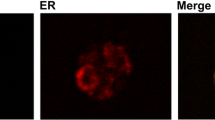Summary
A synthetic gene encoding aprotinin (bovine pancreatic trypsin, inhibitor) was fused to theSaccharomyces cerevisiae prepro alpha mating factor leader sequence at the dibasic amino acid processing site.Pichia pastoris strains were developed to'express one or multiple copies of a methanol-inducible expression cassette containing the gene fusion.P. pastoris containing a single copy of the vector secreed approximately 150 mg/l of immunoreactive protein. A construct bearing five copies of the expression cassette secreted 930 mg/l of aprotinin. The purified aprotinin molecule was equipoten with the native molecule in a trypsin inhibition assay. Protein sequence analysis showed that the alpha factor-aprotinin fusion was not processed at the basic amino acid residues Lys-Arg. Instead, recombinant aprotinin had additional N-terminal amino acids derived from prepro alpha factor. The N-terminal extension was variably 11 or 4 amino acids. Inclusion of the spacer DNA sequence encoding Glu and Ala between aprotinin and the Lys-Arg processing site led to the secretion of a biologically active aprotinin containing only a Glu-Ala N-terminal extension.
Similar content being viewed by others
References
Cohen, B. and G.G. Carmichael. 1986. Laboratory methods: A method for constructing multiple tandem repeats of specific DNA fragments. DNA 5: 343–399.
Cregg, J.M., J.F. Tschopp, C. Stillman, R. Siegel, M. Akong, W.S. Craig, R.G. Buckholz, K.R. Madden, P.A. Kellaris, G.R. Davis, B.L. Smiley, J. Cruze, R. Torregrossa, G. Velicelebi and G.P. Thill. 1987. High-level expression and efficient assembly of hepatitis B surface antigen in the methylotrophic yeastPichia pastoris. Bio/Technology 5: 479–485.
Cregg, J.M., K. Madden, K. Barringer, G. Thill and C. Stillman. 1988. Functional characterization of the two alcohol oxidase genes from the yeast,Pichia pastoris. Mol. Cell. Biol. 9: 1316–1323.
Digan, M.E., S.V. Lair, R.A. Brierley, R.S. Siegel, M.E. Williams, S.B. Ellis, P.A. Kellaris, S.A. Provow, W.S. Craig, G. Velicelebi, M.M. Harpold and G.P. Thill. 1989. Continuous production of a novel lysozyme via secretion from the yeast,Pichia pastoris. Bio/Technology 7: 160–164.
Fioretti, E., M. Angeletti, G. Citro, D. Barra and F. Ascoli. 1987. Kunitz-type inhibitors in human serum. J. Biol. Chem. 262: 3586–3589.
Fuller, R.S., A.J. Brake, and J. Thorner. 1989. Intracellular targeting and structural conservation of a prohormoneprocessing endoprotease. Science 246: 482–486.
Hewlett, G. 1990. Apropos aprotinin: a review. Bio/Technology 8: 566–568.
Hirsch, H.H., P.S. Rendueles and D.H. Wolf. 1989. Yeast (Saccharomyces cerevisiae) proteinases: structure, characteristics and function. In: Molecular and Cell Biology of Yeasts (Walton E.F. and Yarranton, G.T., eds.), pp. 135–200, Van Nostrand Reinhold, New York, NY.
Itoh, H., Y. Fukuda, K. Murata and A. Kimura. 1983. Transformation of intact yeast cells treated with alkali cations. J. Bacteriol. 153: 163–168.
Julius, D., L. Blair, A. Brake, G. Sprague and J. Thorner. 1983. Yeast alpha factor is processed from a larger precursor polypeptide: the essential role of a membrane bound, dipeptidyl aminopeptidase. Cell 32: 839–852.
Koutz, P., G. Davis, C. Stillman, K. Barringer, J. Cregg and G. Thill. 1989. Structural comparison of thePichia pastoris alcohol oxidase genes. Yeast 5: 167–177.
Laskowski, M. and I. Kato. 1980. Protein inhibitors of proteinases. Ann. Rev. Biochem. 49: 593–626.
Markwell, M.K. 1982. A new solid state reagent to iodinate proteins. Anal. Biochem. 125: 427–432.
Sanger, F., A.R. Coulson, B.G. Barrell, A.J. Smith and B.A. Roe, 1980. Cloning in single-stranded bacteriophage as an aid to rapid DNA sequencing. J. Mol. Biol. 143: 161–178.
Schagger, H. and G. von Jagow. 1987. Tricine-sodium dodecyl sulfate-polyacrylamide gel electrophoresis for the separation of proteins in the range from 1 to 100 kDa. Anal. Biochem. 166: 368–379.
Wenzel, H.R., J. Beckmann, A. Mehlich, E. Schnabel and H. Tschesche. 1986. Semisynthetic conversion of the bovine trypsin inhibitor (Kunitz) into an efficient leukocyte-elastase inhibitor by specific valine for lysine substitution in the reactive site.Chem. Pept. Prot. 3: 105–117.
Zoller M.J. and M. Smith. 1983. Oligonucleotide directed mutagenesis of DNA fragments cloned into M13 vectors. In: Methods in Enzymology 100 (Wu, R., Grossman, L., and Moldave, K., eds.), pp. 468–500, Academic Press, New York, NY.
Author information
Authors and Affiliations
Rights and permissions
About this article
Cite this article
Vedvick, T., Buckholz, R.G., Engel, M. et al. High-level secretion of biologically active aprotinin from the yeastPichia pastoris . Journal of Industrial Microbiology 7, 197–201 (1991). https://doi.org/10.1007/BF01575883
Received:
Revised:
Accepted:
Issue Date:
DOI: https://doi.org/10.1007/BF01575883




